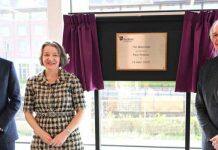Zoom has become a part of the daily routine for many at The University of Texas at Austin since the COVID-19 pandemic made it necessary to move the spring semester online. But preparing for thousands of faculty members, staff members and students to use the popular service for remote instruction and video conferencing was anything but routine. The campus Zoom system was put in place in just days — a task that usually takes weeks, if not months, of planning. At the same time, because of social distancing guidelines, much of the implementation was completed remotely, with team members working together from their at-home screens.


“From all the time that I’ve worked on campus, we’re usually very methodical and deliberate in terms of the way that we introduce new services and thoughtful planning that goes into it,” David Moss, interim associate director for applications and services in Information Technology Services, says. “This was, by necessity, the complete opposite, where things were literally happening in real time.”
Information Technology Services, or ITS, UT’s main IT group, was responsible for the technical implementation and upkeep of Zoom. Liberal Arts Instructional Technology Services, or LAITS, was the instructional and academic face of Zoom for faculty members to help them integrate classes online. After everything was set up, many university groups collaborated to help inform and guide the campus community during the transition to the new online normality.
One piece was in place months before concerns about COVID-19 even existed. IT Leadership Council (ITLC) had been working to secure a contract with Zoom after trying many online services and in the fall selecting the web conferencing tool as the best fit for UT. In January, an ITLC committee was beginning plans for how Zoom would be used for future instructional use. But those plans were quickly fast-tracked.
On March 6, before anyone knew the severity of the disruption to the remaining semester, Trice Humpert, interim assistant vice president of ITS, asked Moss whether he could close a contract with Zoom and have the service running on campus by March 13.
Moss and Mario Guerra, senior information technology manager in the College of Liberal Arts, were responsible for implementing Canvas in 2015. Moss now manages the campus-wide email service, among other services, while Guerra continues to manage Canvas and other instructional tools. The two were essentially tasked with the same mission as when Canvas was introduced to campus, but instead of the two years of planning that Canvas required, they had less than a week to get Zoom running.
“Under normal circumstances, we would have put together a project plan to offer the service campus-wide,” Moss says. “Usually it’s something that would take place over the course of several months and involve a lot of planning and discussion.”
Moss and Guerra both say their work together on the Canvas project helped them feel prepared to tackle Zoom.
“If it was anybody other than Mario, I feel like it would have been difficult for two people that didn’t have the professional relationship that Mario and I did to be able to move this quickly on something, especially given that we both represented these two totally different organizations within the university,” Moss says. “We just hit the ground running and never looked back.”
They used the College of Education’s preexisting contract with Zoom as a template to finalize a new university contract with the company and added more terms and conditions that applied to the whole campus. The contract was secured on Monday, March 9, and they began to get the technology in place on campus.
That same day, Moss and Guerra quickly realized they would need a full team from ITS to accomplish such a major task. While on a Microsoft Teams group chat with Guerra, Moss added five new team members who immediately began working on Zoom.
“One by one, we were pulling people into this group chat, and it was kind of like, ‘Hey, congratulations. You’re part of the Zoom team,’” Moss says. “Everybody was really excited to work on it. We had a really flexible and resilient group of technical folks that were ready.”
The team grew from the original seven members to about 20 people in the first few weeks to respond to the mass of support questions from users. Moss says the team was “almost in a better position” to implement Zoom remotely than if they had done it in person.
“Those couple weeks, there was nothing but Zoom,” Moss says. “So having that very focused attention, and that accelerated timeline, there were no distractions. It also allowed us to almost block out a little bit of what was going on in the rest of the world because we were so singularly focused on this thing with these very aggressive timelines. We knew that the university was essentially counting on us to have Zoom in place in order to have the remote instruction continuity for the semester.”
ONE BY ONE, WE WERE PULLING PEOPLE INTO THIS GROUP CHAT, AND IT WAS KIND OF LIKE, ‘HEY, CONGRATULATIONS. YOU’RE PART OF THE ZOOM TEAM.’
– DAVID MOSS, INTERIM ASSOCIATE DIRECTOR FOR APPLICATIONS AND SERVICES IN INFORMATION TECHNOLOGY SERVICES
After the team successfully integrated Zoom with Canvas and created all user accounts, among other tasks, utexas.zoom.us was silently launched March 13 to begin testing the system.
A few days later, on March 17, then President Gregory L. Fenves announced that the remainder of the spring semester would be conducted online. Groups across campus began working together to navigate this unknown territory.
“It was a campus effort to roll out a system that wide and get faculty, students and staff on board to use it in such a short amount of time,” Guerra says.
LAITS quickly built an instructional continuity help website for the Faculty Innovation Center to provide resources for faculty members. Joseph TenBarge, director of LAITS, says the collaboration efforts were among the most rewarding experiences he’s had in his career.
“We had a 48-hour-long meeting in a LAITS meeting room,” TenBarge says. “LAITS developers and content people sat there and built that website in one long sprint, which was pretty impressive to pull off because it had to happen quickly. It’s been a long time since I’ve pulled a 36-hour shift.”
Multiple colleges’ IT support groups also provided Zoom training and resources for their faculty members during the transition period. Mark McFarland, executive director for information technology in the College of Natural Sciences, brought many of the college IT groups together to ensure a collaborative campus-wide support group for faculty members, TenBarge says.
“The faculty really stepped up,” TenBarge says. “There was almost no bickering about the scope of someone’s responsibilities or whether you were stepping on somebody’s toes someplace. This was true collaboration. It wasn’t just cooperation. People really and truly came together to collaborate.”
The weeks after the system was put in place were used to fix any technical or instructional issues. The first occurrence of “Zoombombing,” the disruption of a Zoom meeting by uninvited users, was reported on the first day of online classes, March 30. Fenves gave direction to take whatever actions were needed to eliminate such interruptions and have the tightest security possible, Guerra says.
The Zoom team immediately worked with the Information Security Office and Cam Beasley, chief information security officer, to determine which settings needed to be adjusted to ensure user authentication before joining a meeting.
“It’s so tough because the more you lock down the service, the less flexible, usable and accessible it is,” Moss says. “But the service can’t tell if you’re a good guy or bad guy right as you’re coming in, unfortunately.”
UT was ahead of the curve: Shortly after the university changed configurations to help prevent Zoombombing, Zoom made similar global settings changes for all accounts.
More than 20,000 university members used Zoom every day during the online spring semester. Now that most staff members, faculty members and students have adjusted to Zoom meetings, Moss says that his team is continuing to support the system and make necessary changes, but instead of every day, changes are made only about once a week, if that. Moss and Guerra are now working to create a solid team with specific roles and responsibilities that can support and manage Zoom until the end of the university’s three-year contract.
Humpert gets emotional when he talks about the “miraculous efforts” that he attributes to all involved on campus in implementing Zoom in such a short time.
“I’ve gotten to interact with people on campus that I’ve never been able to interact with,” Humpert says. “I’ve built relationships that I hope will continue forever. It’s just been a great experience.”







































